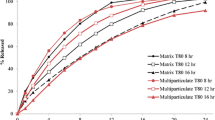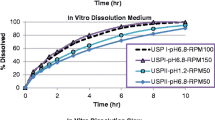Abstract
In vitro–in vivo correlation (IVIVC) models prove very useful during drug formulation development, the setting of dissolution specifications and bio-waiver applications following post approval changes. A convolution-based population approach for developing an IVIVC has recently been proposed as an alternative to traditional deconvolution based methods, which pose some statistical concerns. Our aim in this study was to use a time-scaling approach using a convolution-based technique to successfully develop an IVIVC model for a drug with quite different in vitro and in vivo time scales. The in vitro and the in vivo data were longitudinal in nature with considerable between subject variation in the in vivo data. The model was successfully developed and fitted to the data using the NONMEM package. Model utility was assessed by comparing model-predicted plasma concentration-time profiles with the observed in vivo profiles. This comparison met validation criteria for both internal and external predictability as set out by the regulatory authorities. This study demonstrates that a time-scaling approach may prove useful when attempting to develop an IVIVC for data with the aforementioned properties. It also demonstrates that the convolution-based population approach is quite versatile and that it is capable of producing an IVIVC model with a big difference between the in vitro and in vivo time scales.








Similar content being viewed by others
References
Food and drug administration (1997) Guidance for industry: Extended release oral dosage forms: development, evaluation and application of in vitro–in vivo correlations
European agency for the evaluation of medicinal products (1999) Note for guidance on quality of modified release products. A: Oral dosage forms B: Transdermal dosage forms section I (quality)
United States Pharmacopeia (1993) In vitro and in vivo evaluation of dosage forms. Pharmacopeia Forum 19:5366–5379
United States Pharmacopeia. (1995) Dissolution, Chap. 711. US Pharmacopeial Convention, Rockville, pp 1791–1797
Cardot JM, Beyssac E (1993) In vitro/in vivo correlations: scientific implications and standardisation. Eur J Drug Metab Pharmacokinet 8:113–120
Humbert H, Cabiac MD, Bosshardt H (1994) In vitro–in vivo correlation of a modified release oral form of ketotifen: in vitro dissolution rate specification. J Pharm Sci 83:131–136
Hwang SS, Gorsline J, Louie J, Dye D, Guinta D, Hamel L (1995) In vitro and in vivo evaluation of a once-daily controlled release pseudoephedrine product. J Clin Pharmacol 35:259–267
Mauger DT, Chinchilli VM (1997) In vitro–in vivo relationships for oral extended-release drug products. J Biopharm Stat 7:565–578
Corrigan OI, Devlin Y, Butler J (2003) Influence of dissolution medium buffer composition on ketoprofen release from ER products and in vitro-in vivo correlation. Int J Pharm 254:147–154
Takka S, Sakr A, Goldberg A (2003) A development and validation of an in vitro–in vivo correlation for buspirone hydrochloride extended release tablets. J Control Release 88:147–157
Wing GM (1991) A primer on integral equations of the first kind: the problem of deconvolution and unfolding. Society for Industrial and Applied Mathematics, Philadelphia
Dunne A, Gaynor C, Davis J (2005) Deconvolution based approach for level A in vivo–in vitro correlation modelling: statistical considerations. Clin Res Reg Aff 22:1–14
Gillespie WR (1997) Convolution-based approaches for in vivo–in vitro correlation modelling. Adv Exp Med Bio 423:53–65
Dunne A, O’Hara T, Devane J (1997) Level A in vivo–in vitro correlation: nonlinear models and statistical methodology. J Pharm Sci 86:1245–1249
Dunne A, O’Hara T, Devane J (1999) A new approach to modelling the relationship between in vitro and in vivo drug dissolution/absorption. Stat Med 18:1865–1876
O’Hara T, Hayes S, Davis J, Devane J, Smart T, Dunne A (2001) In vivo–in vitro correlation (IVIVC) modelling incorporating a convolution step. J Pharmacokinet Pharmacodyn 28:277–298
Pitsiu M, Sathyan G, Gupta S, Verotta D (2001) A semi-parametric deconvolution model to establish in vivo–in vitro correlation applied to OROS oxybutynin. J Pharm Sci 90:702–712
Zhang L, Beal S, Sheiner L (2003) Simultaneous vs sequential analysis for population PK/PD data I: best-case performance. J Pharmacokinet Pharmacodyn 30:387–403
Verbeke G, Molenberghs G (2000) Linear mixed models for longitudinal data. Springer, New York
Gaynor C, Dunne A, Davis J (2008) A comparison of the prediction accuracy of two IVIVC modelling techniques. J Pharm Sci 97:3422–3432
Brockmeier D, Dengler HJ, Voegele D (1985) In vitro–in vivo correlation of dissolution, a time scaling problem? Transformation of in vitro results to the in vivo situation, using theophylline as a practical example. Eur J Clin Pharmacol 28:291–300
Rossenu S, Gaynor C, Vermeulen A, Cleton A, Dunne A (2008) A non linear mixed effects IVIVC model for multi-release drug delivery systems. J Pharmacokinet Pharmacodyn 35:423–441
Levy G (1964) Effect of dosage form on drug absorption: a frequent variable in clinical pharmacology. Arch Int Pharmacodyn Ther 152:59–68
Schliecker G, Schmidt C, Fuchs S, Ehinger A, Sandow J, Kissel T (2004) In vitro and in vivo correlation of buserelin release from biodegradable implants using statistical moment analysis. J Control Release 94:25–37
Beal SL, Sheiner LB, Boeckmann A (eds) (1989–2006) NONMEM users guides. ICON Development Solutions, Ellicott
Author information
Authors and Affiliations
Corresponding author
Additional information
Cian Costello—Deceased October 2010.
Appendix
Appendix
The following is the FORTRAN code for the user written PRED subroutine supplied to NONMEM for fitting the IVIVC model. Note that this code calls the numerical integration subroutine DQDAG from the International Mathematical and Statistical Library and consequently this subroutine library must be installed and the nmfeX.bat file must be modified to incorporate its use. The UIR parameters for each subject are estimated separately and read from the file UIR TXT. 



Rights and permissions
About this article
Cite this article
Costello, C., Rossenu, S., Vermeulen, A. et al. A time scaling approach to develop an in vitro–in vivo correlation (IVIVC) model using a convolution-based technique. J Pharmacokinet Pharmacodyn 38, 519–539 (2011). https://doi.org/10.1007/s10928-011-9206-4
Received:
Accepted:
Published:
Issue Date:
DOI: https://doi.org/10.1007/s10928-011-9206-4




